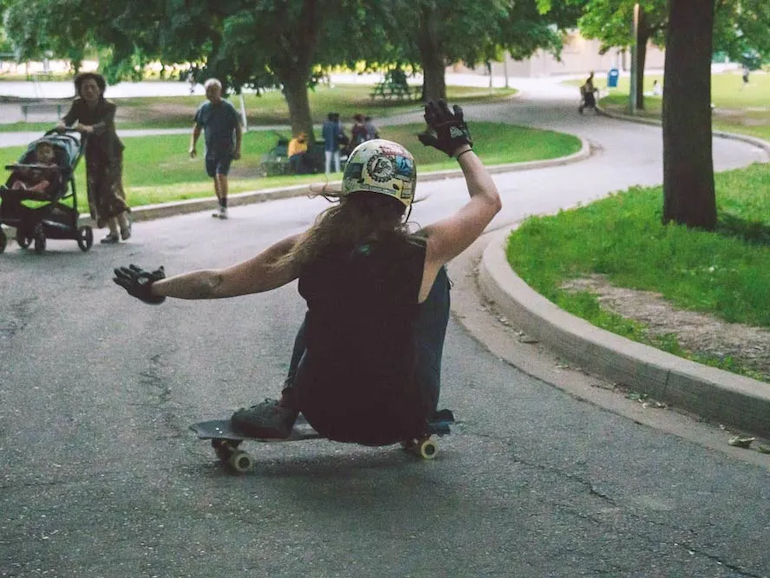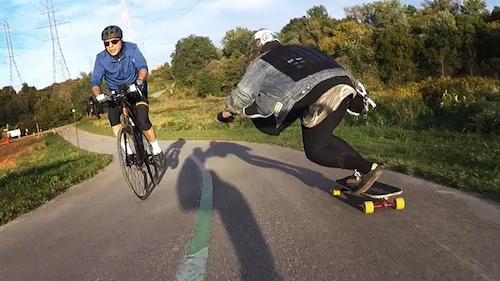Here's how to try longboarding this spring

About 12 years ago, a young Molly Vaclav found longboarding, after watching an older girl ride wearing a summer dress. “I turned to my mom, and with the most certainty I had about anything in my life at that point, I said, ‘That’s what I want to do. That’s who I want to be,’” she says. Now, after moving to Toronto six years ago, Vaclav is a sponsored longboarder with the Landyachtz team and a Longboard Girls crew ambassador. With spring in the air, and summer around the corner, and a need for more solo forms of exercise and fun, we asked Vaclav a few questions about getting into this exciting sport.
For you, what is it that makes longboarding so much fun?
There is so much I enjoy about longboarding. The rush of bombing a hill, the stoke of landing a trick or even the joy of watching someone do something that they’ve been trying really hard to do. One of the things I enjoy the most about longboarding is the real, family-like community it has, especially here in Southern Ontario. Everyone looks out for each other, and people are instinctually supportive of one another. It’s an individual sport, but the people you ride with bring things to the next level.
Is it hard to learn?
Longboarding can definitely be a bit of a challenge to learn, one reason being that the basic mechanics behind moving forward and stopping are contradictory to your body’s intuition. When you’re walking, you spend 50 per cent of the time with either foot on the ground at any given moment. When you’re pushing or stopping on a longboard, you’re spending 100 per cent of the time balancing on one leg while the other leg propels you forward or drags your foot along the ground. Standing on one leg is an innately unstable stance for a person, and when you add in the factor of moving forward or slowing down while you’re balancing on one leg, you can run into a few problems.

 Molly Vaclav
Molly Vaclav
What is the most important thing to remember when picking up longboarding?
One of the most important things to remember when you pick up longboarding is that you are going to suck at it at first, especially if it’s your first board sport. Nobody is good at everything immediately, and it might even take you a really long time to start getting better. The main idea is to keep at it, even when you’re in the middle of getting frustrated with yourself, because if you keep trying, getting better is an inevitability. It might even happen so slowly that you don’t notice yourself getting better over time. Another thing to remember when you’re starting out is, what we call in the community, The Fall. The Fall is a bail that happens early ons when you’re learning how to longboard for the first time, and you injure yourself badly enough to question whether or not you want to keep at it. Falling is a part of riding, and as you get better, not only will it happen less often, but you will learn how to fall in a way that you won’t injure yourself as badly anymore. However, the first real fall can certainly shake up a new rider. Just remember to always wear your helmet and safety gear while you’re learning.
What should I look for in a board? And is it okay to by a used board?
In terms of what type of board I would suggest for a beginner, it depends on whether or not you would like to progress into a certain style of riding. If your main purpose behind getting a longboard is solely to get from point A to point B, any setup you choose will be able to accomplish that, so you can pretty much go for whatever tickles your fancy in a longboard shop. However, for a more comfortable cruise, I would recommend a setup that has a drop-through deck and big, soft wheels. A “drop-through” deck is a style of deck where the trucks are mounted through the board, bringing the deck a little closer to the ground which 1. makes for a more comfortable push and 2. makes the deck a little bit more stable for a beginner. Bigger wheels roll over cracks a lot easier, and a softer durometer will absorb vibrations better.
Buying a used board is definitely okay, and it’s a good option for someone who is on the fence about getting into the sport. If the seller is selling a complete setup, keep in mind that you may have to buy new bearings for the wheels, as sometimes used boards don’t roll that well.
What tips could you offer a beginner to get started?
A few tips I would offer beginners is that if you can find somewhere to take a beginner’s lesson, definitely do it. Living in Northern Ontario, I never had the opportunity to take a lesson when I started longboarding, and I have people that come to my lessons and pick up things within an hour that took me months to learn because I didn’t have someone explaining it to me. Even just longboarding with someone who is better than you can help you become a better rider.
Where is a good place to learn?
A good place to learn would be in a relatively flat parking lot with decent pavement; it doesn’t have to be black-top, but the less gravel or cracks to get your wheels hung up on at low speeds, the better. Paved biking trails are also an option, but they tend to be somewhat narrow, which may be a little challenging to navigate when you’re starting out.
Is it safe to longboard on the sidewalk or biking trails? What's best?
Speaking as someone who longboards in downtown Toronto a lot, the smooth, less populated biking trails are definitely a blessing to ride on. When it comes to bike lanes vs. sidewalks, there’s a couple of factors that come into play. Bike lanes are a lot smoother and less populated, but you have to very aware of your surroundings, which means no riding with headphones in, and keeping tabs on car and bike traffic beside and behind you. Riding on the sidewalk is farther away from the road which makes you safe from cars, but the breaks between each slab of sidewalk pose an obstacle to get your wheels hung up on at slow speeds, and tend to be uncomfortable to ride over at higher speeds. Sidewalks also tend to be quite populated, which can lead to a dangerous game of pedestrian slalom, or having to stop entirely for peoples’ unpredictable movements. I would suggest to someone who’s new to ride on the sidewalk and pick up your board when you see obstacles up ahead. Only when you’re completely comfortable and confident with pushing, footbraking quickly, and looking around while you’re riding (this can take a long time), would I suggest taking it to the bike lane.
Is longboarding good exercise?
Longboarding is great exercise; it’s one of those activities that engages every part of your body at one point or another. Pushing coordinates both your arms and your legs, stopping is an exercise in balance and strength training for your legs, and both require your core to be engaged the entire time to maintain stability. Once you progress enough to start doing flatland or downhill riding, the intensity increases in different ways, depending on the discipline.

 Tweet
Tweet Share
Share